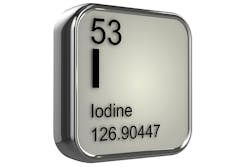Contaminant of the Month: Iodine, iodide & iodate
What is it?
- Iodine is a halogen element in the same series as fluorine, chlorine and bromine. Its atomic number is 53, and its atomic weight is 127. It has several synthetic isotopes including some that are radioactive with short half-lives.
- The element I2 is a black crystalline solid, but its vapors are violet and solutions are brown to purple. It forms a blue complex with starch.
- It is chemically similar to chlorine and bromine, but much less reactive as an oxidizer. Iodide (I–) is an excellent reducing agent.
- Iodine is found in nature as iodide and is easily oxidized to form numerous oxyanions, including iodate
(IO3–), as pH increases. It also forms complexes such as I3–.
Health considerations
- An essential nutrient, iodide or iodate is found in nutritional supplement tablets and used to treat hypothyroidism.
- Iodized (as iodate) table salt was introduced in the U.S. in 1924 to reduce the risk of goiter (hypothyroidism), but people are consuming less iodized salt now.
- Iodine chemicals have many commercial and medical uses such as biocides.
- Tincture of iodine is a topical treatment for small cuts. Providone/Betadine are iodine complexes with polyvinylpyrrolidone in a solution used as surgical scrubs and surface swab disinfectants.
- Iodine contrast media (iodophors), such as iopamidol, are used in some X-ray diagnoses.
- Thyroid hormones, triiodothyroxine (T3) and thyroxine (T4) are important in protein synthesis, enzymatic activity and metabolism, as well as for neurological and skeletal development in fetuses and infants.
- Adequate iodine intake is critical for pregnant women and infants.
- A healthy adult stores about 15 to 20 milligrams (mg) of iodine, mostly in the thyroid.
- Recommended daily intakes range from about 100 to 150 micrograms per day (µg/day) for young children to adults, 220 µg/day during pregnancy and 290 µg/day during lactation.
- Radioactive iodine (I-131) is released during nuclear plant accidents. Its half-life is about eight days. Potassium iodide tablets are protecting agents. The thyroid becomes saturated with iodide, and the radioactive iodine uptake is reduced.
Occurrence & exposure
- Dairy, seafood and some algae are excellent dietary sources of iodine, but grains and other food sources depend on the iodine levels of soil in which they are grown.
- Iodine forms have very low occurrence in drinking water.
- Seawater averages about 1 mg/liter (l). Surface freshwaters have much less. Some localized groundwaters can have microgram to low milli-gram concentrations.
Analytical methods
- Iodometric methods are used in chlorine analyses.
- Catalytic reduction photometric (less than 80 µg/l) and leucocrystal violet methods (more than 50 µg/l) are used in water analyses, as well as inductively couple plasma emission spectrometry (less than 1 µg/l).
Water treatment
- The World Health Organization recommends several iodine products for water disinfection in traveling and emergency situations.
- The iodine species in water are dependent on pH and vary in disinfection efficacy.
- Its point of use and point of entry systems are for water disinfection.
DBPs
- Chlorination and chloramination produce iodinated disinfection byproducts (DPBs) when iodide is present.
- Iodinated trihalomethanes and haloacetic acids and others have been occasionally detected at parts per trillion or low parts per billion levels.
- Some are chemically and biologically active or are cytotoxic in cell culture testing.
- Iodoform (CHI3) was not carcinogenic in animal tests.
- Potential human risk from iodinated DBPs has not been determined.
Water regulation
- Iodine and iodinated organics are not currently regulated, and their future regulatory status is unknown.
- Perchlorate is regulated in a few states because it competes with iodide for transport to the thyroid.
Dr. Joe Cotruvo is president of Joseph Cotruvo and Associates, LLC, Water, Environment and Public Health Consultants. He is a former director of the EPA Drinking Water Standards Division.
